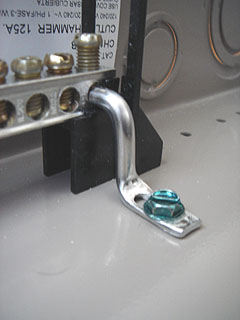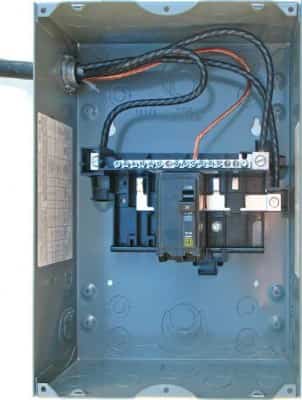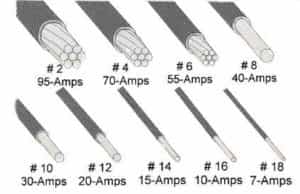In this how-to install a sub-panel installation I will guide you through the complete installation of a subpanel step by step.
The first question is why are you installing a subpanel. There are either one or two reasons to do this. One because you need more room in your existing panel and in that case if your existing panel is old this would be a great time to just upgrade your current service. Newer 200 amp main panels hold a lot more circuits/breakers.
Two, because you need to bring more power somewhere else like a garage you just built or addition or even in some cases a finished basement. Either way, you want to install a subpanel. Ok. So let’s get going.
First: Where do you plan on placing the new sub-panel? If it’s right next to your main panel that’s one thing, but further away like in that new garage you just built 100 feet away you will certainly want to figure in voltage drop. I can’t get too much into that because every setup would be different.
Second: How many amps are you needing for the new sub-panel. So let’s say you need 50 amps. Well, it’s not brain surgery, 50 amp sub panel, 50 amp wire, 50 amp breaker in the existing main panel. See wasn’t that easy.

Neutral Bonding Jumper:
This is very very important. This is also known as a bonding screw. It may even be green. This screw is used to bond the neutral coming in the main panel to the case “panel” itself. however, in a sub panel, the neutral bus bar must be totally isolated from the ground. The very first thing the electrical inspector is going to look for is if the sub-panel is bonded or not.
Now as far as wiring the panel. You would wire it just like any other panel. Hot leads to the breakers, grounds to the ground bus bar, and neutrals to the neutral bus bar.
But Why Do You Need To Remove The Green Screw?
Because the neutral only gets bonded at 1st means of disconnect so any unbalanced load only has one true path to the ground and that’s at the power source.
You would install a 220-volt two-pole breaker in the main existing panel. Whatever the amperage is that you’re using. That breaker gets installed in the main panel of course. This is now the main breaker to your sub-panel. By turning this breaker on or off will control the entire subpanel.
Always remember safety first. Turn the main power off before removing panel covers or touching any wires.
You will need a 4 wire, wire between each panel. No matter how the panel is, this part will always stay the same. You will have two hots, one neutral and one ground. Two hots will go from the new breaker you just installed in the main panel to the sub-panel. A neutral will go from the neutral bus bar in the main panel to the NON bonded bus bar in the sub-panel and ground from the ground bus bar in the main panel to the bus bar in the new sub-panel.



Comments ( 74 )
Great video. Can I use 63UFRL 500 W/GRND underground wire for a sub panel I am putting in a detached Garage. I am going to run it from house to garage about 30 feet and put in a 50 amp breaker in main panel in house.
Thanks
I’ll need more specs on the wire.
Thanks, the wire has red and black and white and a ground. I believe I need to separate or have the ground and neutral on separate buss lines and do away with the connecting bar. I also need to ground the box to the ground buss with the clip attached to the green screw in the box. The ground on the main wire from the house acts as the ground but I also need to put in a ground pole outside. I think this is correct and correct me if I am wrong.
Thanks
Yes, any building not attached to the house will need a separate grounding rod.
Hello and great video. I didn’t find an exact answer to my question.
It has to do with not bonding the neutral and ground on a sub panel.
I have a cabin that I ran 3 wire 2 gauge wire from my main about 300 feet away. I will install a 200 amp sub panel in the cabin along with grounding rods to the panel. Do I still leave the ground and neutral un bonded since I have no ground back to main panel?
Thanks for any help.
Tim
Anything metal is always grounded. The neutral in the sub-panel is isolated (Not bonded)
Thank Dominick
I purchased a main panel and not a sub panel. The panel came with a 200 amp main breaker and also had neutral and ground bars isolated and bonded. The green panel bond was not attached to the ground bar.
I removed the bonding strap between the neutral and ground bar. I attached the panel ground to the ground bar. I sunk two 10’ rods in the ground 8 feet apart and ran 4 gauge copper to the panels ground bar.
Does this all sound right?
Thanks again for your time.
Tim
Sounds right to me. Just make sure the breaker supplying the sub-panel is rated for what you’re doing.
Hey Dominick,
I am working on running a line out to my garage (shop) about 150-200 feet away. The plan is to run a 100 amp breaker from the main out to the shop. I assume given voltage drop, I will need to run a 2-2-2-4 wire at least, correct? essentially a mobile home feeder cable for that kind of length? Also, I plan to one day build a 2 car garage closer to the house and that will need power as well…Is it possible to “splice” or branch that one into the same 100 amp circuit and add a second sub panel? I believe so long as I’m not running enough to pop breakers in both garages at once, that should be fine? I’m going to sink an 8′ ground rod for the shop, which means my sub panel will have the bare copper connected to the ground in the shop’s panel and then I’ll run a #6 from the rod that will also hit the grounding bar, but i will take out the bonding screws/straps, correct?
You can never splice. Not knowing what you have now it’s not that easy to answer. I would really consult a electrician to where he can see what you have and what you want to do. This way you’re safe and legal.
Hey Dominick,
Thanks for the very clear and concise video. I’m running a 150 Amp circuit 100 feet to my carriage house. The one question I can’t seem to get a straight answer on is the size of wire. When using the southwire calculator, as well as some others, it says 2/0 for copper and 3/0 for aluminum. But then I’ve seen elsewhere, including in your comments section, peopler running much smaller wire. Like 2 AWG. Specifically a 2-2-2-4. What is the right size wire?
And second question, do I need to run 2 hot, 1 neutral, and a ground? Since my subpanel is grounded through a ground rod are all 4 wires needed? And does the neutral and/ or ground need to be the same size or can they be smaller?
Thanks again for your great videos and help!
2/0 seems about right. But always check this with your electrical inspector. He’s the one you need to make happy. Oh and yes, always two hots and a neutral. If anything the neutral would be bigger, not smaller. The neutral by itself is the return path for both hots. So never smaller. The ground is smaller,
all my questions were answered .thank you.
So then the neutral and ground wires both connect in the non-bonded singe bar in the picture above, correct?
Yes
installing sub panel in pole barn how deep ser cable needs to be buried w/conduit
By code 20″ but I always always go deeper. Go at least 24″ But if you can do 48″ This way you don’t have to worry about where you plant a tree or something like that.
have a 200 amp main panel. I’m going to install a 50 amp sub panel with # 6 wire in the next stud bay over. I’ll connect the two with a 2” pvc nipple. I need to move 4 circuits out of main panel into sub panel. Can I run the 4 circuits through the pvc nipple or do I disconnect all 4 circuits out of main panel then install them in sub panel. I’m in Washington state.
Thanks Bill
Really whatever works best for you. Just keep it clean